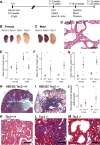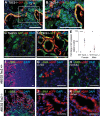Inactivation of Tsc2 in Abcg2 lineage-derived cells drives the appearance of polycystic lesions and fibrosis in the adult kidney
- PMID: 31461347
- PMCID: PMC6879939
- DOI: 10.1152/ajprenal.00629.2018
Inactivation of Tsc2 in Abcg2 lineage-derived cells drives the appearance of polycystic lesions and fibrosis in the adult kidney
Abstract
Tuberous sclerosis complex 2 (TSC2), or tuberin, is a pivotal regulator of the mechanistic target of rapamycin signaling pathway that controls cell survival, proliferation, growth, and migration. Loss of Tsc2 function manifests in organ-specific consequences, the mechanisms of which remain incompletely understood. Recent single cell analysis of the kidney has identified ATP-binding cassette G2 (Abcg2) expression in renal proximal tubules of adult mice as well as a in a novel cell population. The impact in adult kidney of Tsc2 knockdown in the Abcg2-expressing lineage has not been evaluated. We engineered an inducible system in which expression of truncated Tsc2, lacking exons 36-37 with an intact 3' region and polycystin 1, is driven by Abcg2. Here, we demonstrate that selective expression of Tsc2fl36-37 in the Abcg2pos lineage drives recombination in proximal tubule epithelial and rare perivascular mesenchymal cells, which results in progressive proximal tubule injury, impaired kidney function, formation of cystic lesions, and fibrosis in adult mice. These data illustrate the critical importance of Tsc2 function in the Abcg2-expressing proximal tubule epithelium and mesenchyme during the development of cystic lesions and remodeling of kidney parenchyma.
Keywords: ATP-binding cassette G2; polycystic kidney disease; tuberous sclerosis complex 2.
Conflict of interest statement
No conflicts of interest, financial or otherwise, are declared by the authors.
Figures






References
-
- Bissler JJ, Zadjali F, Bridges D, Astrinidis A, Barone S, Yao Y, Redd JR, Siroky BJ, Wang Y, Finley JT, Rusiniak ME, Baumann H, Zahedi K, Gross KW, Soleimani M. Tuberous sclerosis complex exhibits a new renal cystogenic mechanism. Physiol Rep 7: e13983, 2019. doi:10.14814/phy2.13983. - DOI - PMC - PubMed
Publication types
MeSH terms
Substances
Grants and funding
LinkOut - more resources
Full Text Sources
Molecular Biology Databases

